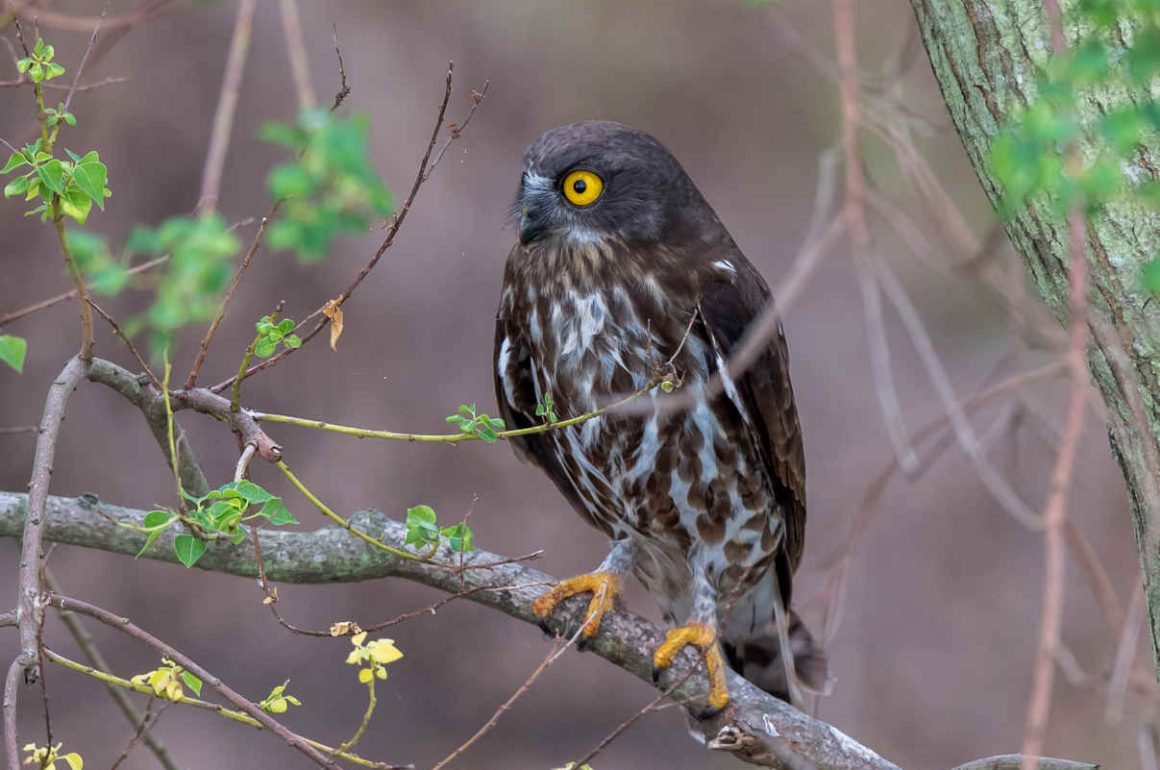
1. On a road trip in the Portuguese interior, we stopped at the Penedo Durão viewpoint. I had just checked out a tree for some movement, and my wife was standing at the cliff edge, asking, “So, where are all those birds you said were here?”. At that very same moment, half a dozen Eurasian Griffons rose on the thermals behind her, so close it seemed she was part of the kettle (PeterPenning).
2. I used to visit the cemetery near our former home. It wasn’t as manicured and perfect-looking as it is now. That made it a great place for birding. I especially liked the pond area, which had been left to go wild. One day in spring, I wandered over to the pond. While standing there, suddenly I had company. Barn Swallows and Tree Swallows were attracted to the flying insects, which had risen from the pond. These birds flew low, turning, twisting, and twittering around me to get those insects. They made me feel as if I was one with them. It was a dizzying, exhilarating feeling, before they flew off, as suddenly as they came (Leslie Kinrys).
3. Seeing seabirds in their environment are some of my most memorable experiences. Albatross, shearwaters, skuas, and other seabirds live such a different life from mine that I cannot help but be fascinated. One of the most incredible times I have had with seabirds was during a pelagic trip out of Westport, Washington, with Westport Seabirds. It was a few months after COVID-19 first struck, and the first group birding I had done since lockdowns. This also meant fewer participants were on the boat due to social distancing, so you had a lot more space to move and see birds.
We were moving from Gray’s Canyon towards Gray Harbor just before noon, when we spotted a Black Cod longliner and a shrimp trawl fleet. Around the boats were thousands of shearwaters floating in the water, hoping for a snack. Most were Sooty Shearwaters, but 500 Pink-footed Shearwaters were mixed in and vocalizing and diving underneath the boat. They were close enough to reach out and touch. It was easy to forget the world and enjoy this special moment with these beautiful birds (Hannah Buschert).
4. I once was on my own in one of the Nanhui microforests, in the days when this was still realistic. I found a Northern Boobook, which was undisturbed by my presence, sitting in a tree about five meters high and ten meters away from me. So I just sat down and quietly watched the bird. It occasionally looked at me, but mostly just seemed to relax. Then, a plane flew high above both of us, and we both looked at it. Somehow, that made me feel the owl and I were quite close (Kai Pflug).
5. If I had to name the single most memorable birding experience, it would probably have to be a pelagic boat trip I undertook around 25 years ago out of the harbour of Simonstown near the tip of South Africa’s Cape Peninsula. Now, being so long ago, I am a bit unsure about the specifics, but I remember that we met very early at the harbour after little sleep (for fear of oversleeping). We were all a bit nervous as the weather had been a bit unstable the days before with decent winds, so there was a certain chance the trip would be cancelled. We were all rather relieved when the captain gave the “green light”, and off we went through the sheltered False Bay to round the Cape of Good Hope, where we were met by significant winds and an impressive swell. We were told later that the trip would have been cancelled had the captain known about this kind of weather, but of course, it was too late now to turn back, and so on we went. The winds and the waves made for excellent sea watching as all the tube noses were active and on the wing, and soon we were surrounded by a constant stream and whirlwind of Giant Petrels and White-chinned Petrels, various prions, and then, of course, the albatrosses. The smaller the last tip of land of the Cape Peninsula at the horizon got, the more common these elegant giants of the sea became, crossing the bow, zooming past alongside the boat, or sometimes even circling around to see what we were up to. The captain and the experienced bird guides, however, had a different plan than just criss-crossing the sea: they checked their radar for one of the fishing trawlers that frequent these waters. And yes, we managed to not only find but also catch up to one and be there the moment it raised his net. The spectacle is something I’ll never forget: literally thousands of albatrosses were swarming the trawler, and thus swarming our little boat right next to it, constantly being at an arm’s length and flying around us in such abundance and diversity it was difficult to focus and not lose one’s mind. By the time we headed back to land, we had seen seven species of albatross, the highlights being a suspiciously brown and very small Wandering, which is suggestive of the rare Tristan Albatross, a Grey-headed, and a Northern Royal. Toss in an Antarctic Fulmar and a Soft-plumaged Petrel, top it off with a Bryde’s Whale right next to the boat, and it is difficult not to name such an experience as the most memorable of one’s birding life (Jochen Roeder).
6. Every birding experience is memorable in one way or another, and, after having been a birder for nearly half a century, no one moment stands above the rest. However, I had a heck of a lot of highlights while volunteering for Rainforest Expeditions in the Peruvian Amazon. Blue and Gold Macaws screaming in our ears as they flew too close for binocular views. Seeing a pair of fearless Harpy Eagles at such close range, I felt a deep instinct to get the heck out of there. Extremely close looks at Amazonian Parrotlets (the original “parrot without a name”) at a small clay lick, witnessing the multi-sensory din and emotion of 1,000s of parrots and parakeets, and macaws visiting a larger clay lick…the list goes on.
Other incredible memories include sharing massive fall migration with friends at Cape May (a weedy field where Common Yellowthroats flushed with every step, warblers, tanagers, grosbeaks, cuckoos and more in every bush and tree), being 8 and seeing a dozen Ruffed Grouse flush from raspberry thickets in Pennsylvania woods as my 6 foot 6 uncle outstretched his arms and excitedly exclaimed, “Ruffed Grouse! Ruffed Grouse!”. From that same 1979 trip, I still clearly recall and cherish the first time I saw a stunning Eastern Bluebird hovering over a meadow, blue plumage shining sapphire in the morning sun. I can still see my young self realizing that yes (!) Indigo Buntings and Black-throated Green Warblers were real. I am grateful that there are too many bird memories to take that top spot (Patrick O’Donnell).
7. Would you walk through a minefield to see a bird? I did so once, and didn’t think a lot about it at the time. I was on a birding trip to Zimbabwe, not long after the end of the civil war. I was staying at Victoria Falls and was told that if I walked down a path to one of the lower gorges, there was a good chance of seeing a pair of Taita Falcons that were nesting there. The Taita Falcon is rather like a small Peregrine, and is a highly localised resident in eastern and southern Africa. My informant did tell me exactly where to go to see the falcons, but added that the ground surrounding the path had been heavily mined. There were sinister-looking warning signs telling you to keep to the path. I obeyed and did see the falcons.
Though I’ve watched birds on every continent except Antarctica, it’s Africa where I’ve had the most memorable experiences. I’ve been charged by a young bull elephant while walking in Botswana’s Okavango Delta and had a companion tossed by a buffalo while looking for Water Thick-knees along the Mara River in Kenya (he survived). But perhaps my favourite birding recollection from Africa is from the West African country of Ghana. Our guides had taken us to a small village deep in the forest, and it was from here that we trekked for an hour to a nesting site of the legendary Picathartes – the Bare-necked Rockfowl. We arrived at the site at 4 pm, then sat down on hard wooden benches to await the birds’ arrival. Nothing happened at all for the next hour – not a bird moved or called, nothing. The only sound was the distant sound of a chainsaw, the cry of the rainforest. One of my companions managed to drop off to sleep. We sat in absolute silence. The next hour was equally blank, and I was beginning to wonder whether we would ever see our quarry. The guides who had escorted us had assured us that they had never failed. Another 30 minutes passed, and the light was starting to fade. Night falls quickly in the tropics, so it was now or never. And then, quite suddenly, there they were. Three, or perhaps four, improbable-looking birds, running around on the forest floor. Picathartes! The long wait had been worthwhile (David Tomlinson).


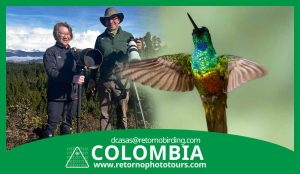
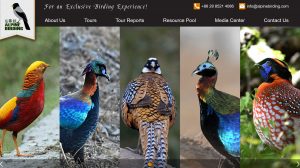
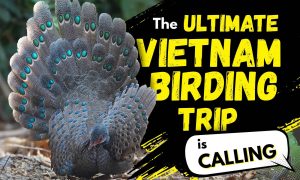
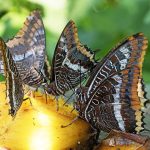
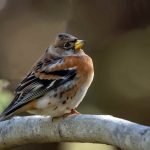


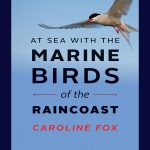
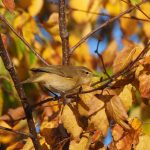
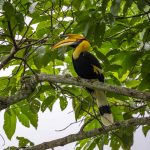
By one Bosnian birder, I was offered a capercaillie tour inside a mine field. I politely declined.
Why, Dragan, why? Capercaillies are so worth it…!
Last June I happened to be in Durban at the same time of the first reliable sighting of a Mascarene Martin (Phedina borbonica) in South Africa. My tour guide was very eager to visit that site a little north of the city since that would be his 650th species in his home country. And lo and behold, I got to see it together with about 30 other lifers in one day. A few days later, a colleague at the math conference that I was attending told me that the bird had been taken down by a falcon under the eyes of birders. The story even made it into the local newspaper.